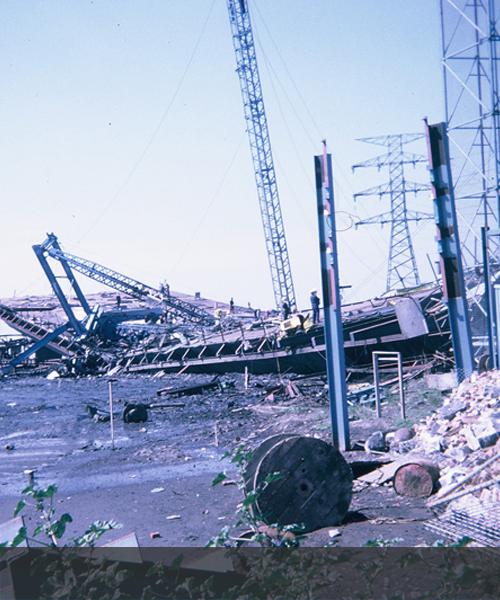There were some miraculous tales of survival which came out in the days and weeks that followed the disaster.
In those interminable seconds before the huge span plummeted 45 metres (150 feet) into the mud and waters of Melbourne’s River Yarra, a young migrant, boilermaker’s assistant, Charlie Sant, had the presence of mind to sit down on a box and await the worst. It was too late to run.
Some others alongside him rode the bridge down and, while they didn’t walk away, managed to smile through their pain as rescue workers reached them.
Then there was rigger Ed Halsall who looked up from the ground and saw the bridge falling on him. His legs took over from his numbed brain and he found himself running at full pelt.
As he ran the impact of the span hitting the ground sent a blast of wind behind Ed which lifted him off the ground and flung him to safety.
And assistant rigger Des Gibson still couldn’t work out what happened to him. He was on one knee working on top of the span when it opened up in front of him like an earthquake’s gash. He toppled forward into the bowels of the hollow span and went down inside, bouncing around like a rubber ball. Not even a bone was broken.
(Extracts from ‘Disaster!’ ISBN 0 86860 056 3)
Desmond Gibson was 29 when the bridge went down with him inside it, praying. He turned grey within months. His recurring terrible dreams of the bridge falling brought on three heart attacks. His death on August 4, 1973 - from his fourth attack - at the age of 32 brought the number of men the bridge has killed to 37. The toll had reached 36 in December 1972 when a rigger working on the bridge reconstruction fell 170 ft to his death.
Derrick driver Vincent Rosewarne, 24 of Hastings, can thank a small piece of wire mesh. It cushioned his fall and bounced him back into the air like a trampoline while the bridge crashed around him. Vince ended up with a broken nose, two broken arms and a fractured leg.
The only thing Scots-born rigger Brian Fullerton, 24, could remember was waking up in hospital with his head bandaged and a long scar across his face. His mates in the Federated Ironworkers Union paid for his mother, Mrs Sidney Seay, to fly over from New Zealand to see him.
‘I feel as if I’ve just gone ten rounds with Lionel Rose,’ said John Thwaites, 42, who grabbed a girder and held on all the way down. He suffered multiple serious injuries.
John Laino was still wearing his John Holland safety helmet after the span went down, and boilermaker George Stassoulakos of Northcote also escaped without a scratch. ‘I felt a shake,’ said George who was walking along a catwalk at the time, ‘but I thought it was one of my mates doing something above me.
‘But the shaking continued and I knew something had to be wrong. The bridge started to sink. quietly and smoothly. It was like slow motion. I grabbed the ropes of the catwalk and the next thing I knew I was under the water. When I surfaced I waited for the bridge to come down on me, but it was not there any more. I saw two blokes and they were hurt, but they could walk. We just waded out of the water, and lay on the bank. All around me I could see people. All hurt. All pieces.’
Section Engineer Bill Tracy, 28, of Cheltenham, rigger, Desmond Gibson, 29, of Preston and rigger Frank Piermarini, 34, of Lalor were among the initial survivors.
Frank, a rigger, and an Italian, could not remember much of the crash. ‘As I tried to scramble out the world seemed to go into a massive slide,’ he said in hospital later that day. ‘By some grace of God I was spared.’
Bill Tracy died three weeks later without regaining consciousness.
Frank Piermarini died 10 weeks later.
Desmond Gibson had nearly three years of nightmares and heart attacks before he died in August 1973.
Extract from ‘West Gate’ by Bill Hitchings

